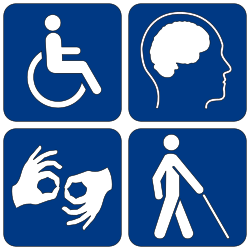Universal design
The universal design is a relatively new design paradigm, which directs its actions towards the development of products and environments that are easily accessible to the greatest number of people possible, without the need to adapt or redesign them in any way. a special way. The concept arises from barrier-free design, accessible design and assistive technology. Unlike these concepts, universal design encompasses all aspects of accessibility, and addresses all people, including people with disabilities. Solve the problem with a holistic vision, based on the idea of human diversity. In addition, it takes into account the way in which the product is sold and the image of the product, so that these, in addition to being accessible, can be sold and capture the entire range of consumers.
The purpose of universal design is to simplify the performance of everyday tasks by building products, services and environments that are easier to use by all people and without any effort. Universal design thus benefits all people of all ages and abilities.
Principles of Universal Design
Some authors, a group of architects, product designers, engineers, and environmental design researchers have collaborated to establish the following universal design principles for guidance in a range of design disciplines, including environment, product, and communications.:
- Equal use: design should be easy to use and suitable for all people regardless of their abilities and skills.
- Flexibility: design must be able to fit a wide range of individual preferences and skills.
- Simple and intuitive: design should be easy to understand regardless of the experience, knowledge, skills or level of user concentration.
- Easily perceived information: the design must be able to exchange information with user, regardless of the environmental conditions or sensory capabilities of the design.
- Tolerant to errors: design should minimize accidental or fortuitous actions that may have fatal or undesired consequences.
- Short physical effort: design must be used effectively and with the least possible effort.
- Appropriate dimensions: sizes and spaces must be appropriate for the user's scope, manipulation and use, regardless of their size, position, and mobility.
In July 2015, the Graphic Design Unit of the UN Department of Public Information in New York designed a new accessibility symbol. The figure, with open arms, symbolizes inclusion for people regardless of their abilities. The accessibility logo was created to represent “accessibility”, including the accessibility of information, services, communication technologies, as well as physical access. The greatest strength of this symbol is to make the concept "accessibility" independent and not associate it with a figure that we naturally associate with "disability".
Examples of Universal Design
- Floor with soft surfaces in the access roads to the buildings, without steps.
- Spacious inner doors, in which a wheelchair burns.
- Bathrooms adapted.
- Buttons on the control boards that can be distinguished by the touch.
- Bright and appropriate illumination, particularly in jobs.
- redundant audible output with visual information.
- Output visual redundant with audible information.
- Contrast control in the output visuals.
- The use of significant icons, as well as the text.
- Clear vision line (to reduce sound dependence).
- Volume control in the output audible.
- Speed control in the output audible.
- Election of language output written or spoken.
- Access ramps in swimming pools and all buildings.
- Closed Caption (subtitled in real time) on television.
- Keys and large numbers on the phones.
Universal design and social inclusion
Universal design is an essential part of the strategy to achieve a society in which all people can participate. A model of society that is being redefined based on the inclusion of all and that derives, to a large extent, from reflection on the way that society wants to welcome the person in all their diversity. One ingredient of this diversity is disability. In this social model, the values of equal opportunities and respect for the rights of all prevail. In this sense, universal design proposes the design of the environment, buildings, services, etc., so that they can be used by the greatest number of people, including people with disabilities and the elderly, in the most autonomous way. possible. This design philosophy has become a topic of general interest in the main programs of the European institutions, sometimes using equivalent terms, or that converge towards the same concept of inclusive society: design for all, inclusive design, universal accessibility.
Contenido relacionado
LZ 129 Hindenburg
Wheatstone bridge
Hall–Héroult process
